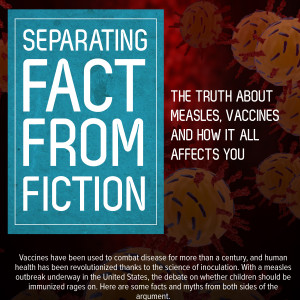Separating Fact From Fiction: The Truth About Measles, Vaccines and How It All Affects You
Vaccines have been used to combat disease for more than a century, and human health has been revolutionized thanks to the science of inoculation. With a measles outbreak underway in the United States, the debate on whether children should be immunized rages on. Here are some facts and myths from both sides of the argument.
How Do Vaccines Work?
Vaccines expose the body to a dead or weakened antigen, and the immune system automatically creates an antibody to fight the disease the next time we come into contact with it. The antibodies in our immune systems are programmed to remember their encounter with a virus and instinctively know to destroy it. (1)
The measles vaccine requires two applications in order to administer full protection. Dose 1 is administered from 12-15 months of age. Dose 2 is administered at ages 4-6. (1)
The Rise and Fall (and Rise) of Measles
Before widespread vaccinations, measles killed millions of children around the world every year. Measles vaccination programs led to a 75% drop in global measles deaths between 2000 and 2013. (2)
U.S. measles cases reported, select years (1, 3)
1950: 318,124
1960: 441,073
1970: 47,351
1980: 13,506
1990: 27,786
2000: 26
2010: 63
2013: 195
2014: 640
The rise in U.S. measles outbreaks has been primarily among the unvaccinated population. (1)
Understanding the U.S. Outbreak
Dozens of measles cases have been reported across the U.S. Where are the cases, and why did this outbreak happen?
States affected by current measles outbreak (cases per state through Feb. 6) (1)
Arizona: 7
California: 99
Colorado: 1
Nebraska: 1
Oregon: 1
Utah: 3
Washington: 2
The current outbreak has heightened discussion of the anti-vaccination movement, as experts suspect non-vaccinated individuals have helped spread the disease. And because measles is so highly transmittable, even those who have been vaccinated are at risk from unvaccinated people.
Doctors expect 3% of the vaccinated population to contract measles from unvaccinated persons. (4)
95%
Recommended proportion of population that needs to be vaccinated to stop the spread of measles, according to studies (5)
Vaccinated individuals who contract the virus aren’t as contagious as unvaccinated people who become infected. (4)
From 2009-2012, thousands of kindergarteners across the country have been reported exempt from vaccines because of medical, religious or other reasons.
Exemptions by state (1)
Alabama: 465
Alaska: 53
Arizona: 3,187
Arkansas: 1,402
California: 13,536
Colorado: 18
Connecticut: 609
Delaware: 7
District of Columbia: 144
Florida: 3,495
Georgia: 59
Hawaii: 60
Idaho: 1,226
Illinois: 9,015
Indiana: 651
Iowa: 607
Kansas: 455
Kentucky: 318
Louisiana: 550
Maine: 517
Maryland: 454
Massachusetts: 1,067
Michigan: 6,932
Minnesota: 1,145
Mississippi: 16
Missouri: 90
Montana: 364
Nebraska: 377
Nevada: 42
New Hampshire: 285
New Jersey: 1,504
New Mexico: 12
New York: 1,614
North Carolina: 1,003
North Dakota: 5
Ohio: 1,857
Oklahoma: 548
Oregon: 2,728
Pennsylvania: 2,681
Rhode Island: 17
South Carolina: 64
South Dakota: 150
Tennessee: 570
Texas: 5,947
Utah: 2,032
Vermont: 372
Virginia: 76
Washington: 3,472
West Virginia: 44
Wisconsin: 76
Measles Fact and Fiction
Fact: The virus can remain active in the air for up to two hours, and is spread through coughing, sneezing and close contact with infected individuals. (6)
Myth: Children born to vaccinated mothers are automatically immunized and do not need their own dose. (7)
Fact: Anyone who received the measles vaccine prior to 1968 should be immunized again, as vaccines during that period could not fully protect an individual. (6)
Myth: Contracting the disease naturally gives you better immunity than receiving a vaccine. (1)
Fact: Symptoms of measles include runny nose, cough, red rash and fever. (2)
Myth: Other vaccinated people will help to keep non-immunized families protected. (8)
Fact: In 2013, there were nearly 400 deaths per day, globally due to the measles virus. (2)
Myth: Vaccine side effects are worse than the actual disease. (9)
Fact: Measles is one of the leading causes of death among young children worldwide. (2)
Myth: The MMR vaccine causes childhood disorders, including autism. (9)
Sources:
1. http://www.cdc.gov
2. http://www.who.int
3. http://www.historyofvaccines.org
4. http://www.usatoday.com
5. http://www.livescience.com
6. http://healthvermont.gov
7. http://www.health.com
8. http://www.parenting.com
9. http://www.texaschildrens.org

